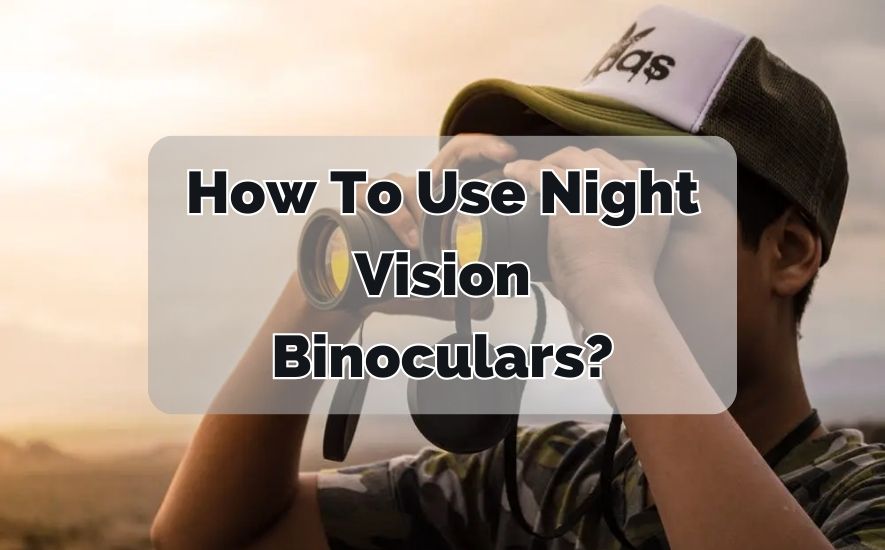Welcome to the fascinating world of night vision binoculars! If you love exploring the great outdoors, observing wildlife, or stargazing after dark, these cutting-edge optical devices are sure to enhance your nocturnal adventures.
Night vision binoculars are designed to amplify ambient light, enabling you to see clearly in low-light conditions, making them an invaluable tool for various activities like camping, surveillance, and night navigation.
In this guide, we’ll walk you through the essential steps of how to use night vision binoculars effectively, so you can make the most out of your night-time experiences.
How To Use Night Vision Binoculars? To use night vision binoculars, first, familiarize yourself with their features and functions, such as focus, gain, and IR illuminator settings. Avoid pointing them at bright light sources, and refer to the user manual for specific calibration and customization instructions. Handle the binoculars with care to ensure optimal performance.
To begin using your night vision binoculars, the first step is to familiarize yourself with their features and functions. Famously recognized as NVBs, these compact yet powerful gadgets employ an image intensifier tube to amplify incoming light and present it in a visible form.
Typically, they come equipped with adjustable focus, gain, and IR (infrared) illuminator settings, each serving a specific purpose in optimizing your night vision. Once you understand the basic controls, ensure your binoculars are powered up and make sure to avoid pointing them at bright light sources, as it may damage the sensitive components.
So, let’s dive into the comprehensive guide, where you’ll learn how to calibrate and customize the settings, handle them properly, and unlock the full potential of your night vision binoculars.
A Beginner’s Guide to Night Vision Binoculars

Night vision binoculars are powerful optical devices that enable you to see clearly in low-light conditions and even in complete darkness. Whether you’re an outdoor enthusiast, a nature lover, a hunter, or simply curious about the nocturnal world, night vision binoculars can be an exciting addition to your gear.
Understanding Night Vision Technology:
Night vision binoculars work on the principle of capturing and amplifying available light, such as moonlight or ambient light, to produce a visible image. The core technology involves a photocathode that converts photons from light into electrons, which are then accelerated and focused to create an intensified image.
The resulting image is displayed through an eyepiece, allowing you to see clearly in dark environments.
Types of Night Vision Binoculars:
Generation 1
These are entry-level night vision binoculars and are suitable for casual use. They offer a limited range and image clarity compared to higher generations but are more affordable, making them a great starting point for beginners.
Generation 2
These binoculars provide better image quality and range compared to Gen 1. They are often used by professionals and outdoor enthusiasts who require more dependable performance in low-light conditions.
Generation 3
Gen 3 binoculars offer superior image clarity, extended range, and overall performance. They are the choice of law enforcement, military personnel, and serious night vision users who demand the best possible visual capabilities.
Key Features to Consider
Magnification and Lens Size
Consider the magnification power and objective lens diameter, as they determine the binoculars’ ability to gather light and provide a clear view. Higher magnification may lead to a narrower field of view, so strike a balance based on your intended use.
Infrared Illuminator
Some night vision binoculars come with a built-in infrared (IR) illuminator, which emits infrared light to enhance visibility in complete darkness. This feature can significantly improve your nighttime experience.
Range and Detection Distance
Check the manufacturer’s specifications for the effective range and detection distance of the binoculars. These values indicate how far you can see and identify objects in low-light conditions.
Battery Life
Opt for binoculars with long-lasting battery life, as it ensures you won’t be left in the dark during critical moments. Rechargeable batteries can be a convenient and eco-friendly option.
Ergonomics and Weight
Consider the weight and design of the binoculars, especially if you plan to use them for extended periods. Comfortable ergonomics will prevent fatigue and enhance your overall experience.
Tips for Using Night Vision Binoculars:
Familiarize Yourself
Before heading into complete darkness, practice using your binoculars in well-lit environments to understand their features and controls.
Reduce Ambient Light
To maximize night vision performance, avoid using bright lights or flashlights while using your binoculars in the dark.
Adjust the Focus
Take the time to properly focus your binoculars for a clear and crisp image.
Experiment with IR Illuminator
If your binoculars have an IR illuminator, experiment with different intensity settings to find the one that best suits your needs.
Tips for Properly Using and Maintaining Night Vision Binoculars

Night vision binoculars are sophisticated optical devices that offer a glimpse into the nocturnal world. To get the most out of these impressive tools and ensure their longevity, it’s essential to understand the proper methods of usage and maintenance.
Understand the Night Vision Technology:
Before diving into the darkness, familiarize yourself with the night vision technology used in your binoculars. Know the different generations (Gen 1, Gen 2, Gen 3) and their capabilities. This knowledge will help you set realistic expectations and utilize the features effectively.
Choose the Right Environment:
Night vision binoculars perform best in low-light conditions, such as moonlit nights or under a starry sky. Avoid using them in brightly lit areas, as this may overload the sensors and compromise image quality. To optimize performance, venture into natural, dimly lit environments.
Adjust the Focus and Diopter Settings:
Properly focusing your binoculars is crucial for clear vision. Adjust the central focus wheel to achieve a sharp image. Additionally, most night vision binoculars come with diopter settings for each eyepiece.
Take the time to set these correctly for your eyes, as it significantly improves viewing comfort.
Utilize the Infrared (IR) Illuminator Wisely:
If your night vision binoculars have an IR illuminator, use it judiciously. The IR light is invisible to the naked eye but enhances visibility in complete darkness. Experiment with different intensity levels to find the optimal setting for your specific environment.
Reduce Exposure to Bright Light:
To protect the sensitive components of your night vision binoculars, avoid exposing them to direct bright light, especially sunlight. Extended exposure may cause damage to the intensifier tube and decrease overall performance.
Clean the Lenses Carefully:
Regularly clean the objective and eyepiece lenses using a soft microfiber cloth. Avoid using rough materials or excessive force, as this can scratch the delicate coatings. If needed, slightly dampen the cloth with a gentle lens cleaning solution.
Store Properly:
When not in use, store your night vision binoculars in a protective case or a dry and dust-free environment. Make sure to remove the batteries to prevent leakage and damage.
Check Battery Levels:
Always check the battery levels before heading out into the dark. Low batteries can lead to reduced performance or sudden shutdowns, interrupting your nighttime adventure.
Avoid Impact and Rough Handling:
Night vision binoculars are delicate instruments, so handle them with care. Avoid dropping or subjecting them to sudden impacts, as this can damage the internal components and optics.
Mastering the Art of Adjusting Gain and IR Illuminator

Adjusting gain and IR illuminator settings is a crucial aspect of optimizing surveillance camera performance in various scenarios. It allows for improved image clarity and visibility in low-light conditions, making it an essential skill for security professionals and enthusiasts alike.
Understanding Gain and IR Illuminator:
Before delving into the adjustments, it is essential to comprehend the two key components involved – gain and IR illuminator. Gain refers to the amplification of the camera’s sensitivity to light.
While it can enhance low-light images, excessive gain can introduce noise and reduce image quality. On the other hand, the IR illuminator emits infrared light, which is invisible to the human eye but can be detected by the camera’s sensor, enabling better visibility in complete darkness.
Selecting the Appropriate Camera Settings:
The initial step in mastering this art is to select the appropriate camera settings. The gain should be adjusted based on the available ambient light, keeping in mind that high gain may lead to image distortion.
It is recommended to start with the lowest possible gain setting and gradually increase it until the desired visibility is achieved without compromising image quality. For the IR illuminator, it should be activated when the natural light is insufficient for clear imaging.
Proper positioning and coverage range of the IR illuminator are crucial factors to consider.
Minimizing Noise with Digital and Analog Gain Balance:
To achieve optimal results, it is essential to strike a balance between digital and analog gain settings. Over-reliance on digital gain can introduce pixelation and noise, reducing image clarity.
In contrast, an appropriate combination of digital and analog gain can minimize noise and retain image details, ensuring clearer surveillance footage.
Utilizing Day/Night Cameras:
Day/Night cameras are designed to adapt to varying lighting conditions effectively. During daylight, these cameras produce full-color images with minimal gain, resulting in sharper and more vibrant visuals.
As the light diminishes, they automatically switch to infrared mode, utilizing the IR illuminator to provide clear black-and-white images in low-light or dark conditions.
Avoiding Overexposure and Hotspots:
While adjusting gain and IR illuminator, it is crucial to be mindful of overexposure and hotspots. Overexposure occurs when too much light floods the camera sensor, resulting in loss of detail and image quality.
To counter this, manual exposure settings can be utilized, allowing users to control the amount of light reaching the sensor. Hotspots are bright areas that may occur due to excessive IR light concentration. Proper positioning and angling of the IR illuminator can help mitigate this issue.
Regular Maintenance and Calibration:
Achieving mastery in adjusting gain and IR illuminator also involves consistent camera maintenance and calibration. Dust and debris can accumulate on the camera lens or IR illuminator, impacting image quality.
Regular cleaning and calibration ensure optimal performance and extend the lifespan of the surveillance equipment.
Conclusion
Mastering the art of using night vision binoculars can open up a whole new world of exploration and excitement under the cover of darkness. As we’ve learned, understanding the fundamental principles of these devices and their features is crucial for optimal performance.
Whether you’re an outdoor enthusiast, a wildlife observer, or a night adventurer, night vision binoculars offer invaluable capabilities to enhance your experiences.
Remember to choose the right generation of night vision binoculars for your needs, be aware of ambient light conditions, and familiarize yourself with the adjustments to achieve the best image quality. Additionally, employing stealth and patience while observing wildlife will yield the most rewarding encounters.
Embrace the wonders that the night has to offer, and may your night vision binoculars be your loyal companion in unraveling the mysteries of the dark, unseen world around us.
Frequently Asked Questions (How To Use Night Vision Binoculars?) FAQs
How do you use night binoculars?
Using night binoculars is simple once you get the hang of it. First, ensure you are in a low-light environment, as these binoculars are specifically designed for use in darkness. Next, adjust the interpapillary distance, which is the distance between the eyepieces, to match the width of your eyes. This will provide a comfortable and clear view.
To focus the binoculars, look at an object at a moderate distance and turn the focus wheel until the image becomes sharp and clear. Night binoculars may have an infrared illuminator that emits infrared light to enhance visibility in total darkness.
When needed, activate the infrared illuminator, but be cautious as it may attract attention in sensitive situations.Remember, using night binoculars requires some practice, so take your time and experiment with different settings to get the best results.
How do night vision binoculars work?
Night vision binoculars are fascinating devices that allow us to see in low-light conditions and even in total darkness. They utilize advanced technology that involves several key components to function.
Firstly, night vision binoculars have objective lenses that gather available ambient light, such as moonlight or starlight, and pass it through an image intensifier tube. This tube amplifies the incoming light using a photocathode, converting photons into electrons.
The intensified electrons then pass through a microchannel plate, where they undergo rapid multiplication, significantly increasing their numbers. This process is called electron cascade, and it plays a crucial role in boosting the brightness of the image.After the electron cascade, the electrons strike a phosphor screen at the back of the image intensifier tube.
As a result, the electrons are converted back into photons, generating a visible green-hued image that we can see through the eyepiece.In summary, night vision binoculars work by gathering ambient light, amplifying it through an image intensifier tube via electron multiplication, and presenting the enhanced image to the user through the eyepiece.
What is the range of night vision binoculars?
The range of night vision binoculars can vary depending on the model and its specifications. Typically, the range of night vision binoculars is determined by the performance of their image intensifier tubes, the quality of objective lenses, and the presence of an infrared illuminator.
For entry-level night vision binoculars, the effective range can be around 100 to 200 yards (approximately 91 to 183 meters) in optimal low-light conditions. However, as you invest in higher-end models with advanced technology, the range can significantly improve.
Premium night vision binoculars equipped with high-performance image intensifier tubes and quality lenses may offer a range of up to 1000 yards (approximately 914 meters) or more.
Additionally, binoculars with built-in infrared illuminators can extend the effective range further, allowing visibility in pitch-dark environments.
It’s important to note that while the range of night vision binoculars is a crucial factor, the overall performance is influenced by various other factors such as atmospheric conditions and the level of ambient light available.
Can you use night vision binoculars during the day?
It is generally not recommended to use night vision binoculars during the day. Night vision devices are designed to work in low-light or dark conditions and are not suitable for use in bright daylight.
Using night vision binoculars during the day can cause significant damage to the device’s image intensifier tube. The intense levels of visible light during daytime can overwhelm the sensitive components of the tube, potentially leading to permanent damage.
Moreover, when exposed to bright light, the phosphor screen within the image intensifier tube may experience “burn-in” issues, where a temporary or permanent afterglow appears on the screen, affecting the image quality.
To avoid damaging your night vision binoculars, it’s crucial to follow the manufacturer’s guidelines and only use them in low-light or dark environments as intended.If daytime observation is necessary, consider using regular binoculars suitable for daylight conditions to ensure the longevity and proper functionality of your night vision device.




